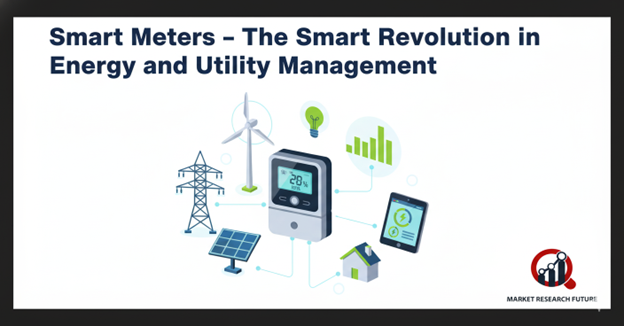Smart Meters – The Smart Revolution in Energy and Utility Management

Smart Meters Market Overview
In an era where everything—from televisions to fitness devices—has turned “smart,” energy and utility systems are also undergoing a technological transformation. Smart meters, designed for electricity, gas, and water tracking, are redefining how consumers and suppliers interact with energy usage data. These next-generation devices eliminate the inaccuracies of manual readings and the inconvenience of estimated billing, ensuring efficiency, transparency, and sustainability in resource management.
What are Smart Meters?
Smart meters are advanced digital devices that automatically record and transmit real-time data on electricity, gas, or water consumption to utility providers. Unlike traditional meters that rely on manual readings, smart meters communicate directly through secure networks, ensuring precise billing and continuous monitoring.
By providing two-way communication between consumers and suppliers, smart meters support better demand management, help reduce energy wastage, and promote efficient energy distribution—key pillars of sustainable infrastructure development.
Key Benefits of Smart Meters
- Accurate Energy Measurement: Smart meters record actual usage in real time, ensuring consumers are billed only for the energy they use—eliminating discrepancies from estimated readings.
- Transparency and Reliability: Automated data transmission builds trust between consumers and suppliers by providing reliable and transparent billing information.
- Cost and Energy Efficiency: Continuous monitoring allows consumers to identify high-usage patterns and adjust consumption habits, leading to significant savings.
- Ease of Recharge and Balance Management: Consumers can conveniently top up or pay bills online or via local stores, removing the hassle of manual payments or office visits.
- Environmental Sustainability: By encouraging responsible energy usage, smart meters contribute to reduced carbon emissions and promote long-term sustainability.
Implementation and Working Mechanism
Smart meters operate on digital communication networks that connect users and energy providers in real time. Their implementation can be broadly understood through the following stages:
- Installation and Integration: Smart meters replace conventional meters, connecting directly to a digital communication infrastructure—often via IoT or wireless networks.
- Data Collection and Transmission: These devices record consumption data at regular intervals and automatically send it to the energy supplier without human intervention.
- Billing and Monitoring: Consumers receive accurate bills based on real-time data, while suppliers can monitor demand trends and manage supply efficiently.
This intelligent feedback loop enables consumers to make informed energy choices and allows providers to optimize grid performance and forecast future energy needs effectively.
Market Growth Drivers
The global smart meters market is expanding rapidly, driven by multiple economic, technological, and environmental factors:
- Government Smart Grid Initiatives: Public sector programs in countries such as the U.K., U.S., and India are promoting large-scale smart meter deployment to modernize energy infrastructure.
- Growing Energy Conservation Awareness: Rising concerns about energy wastage and carbon footprints are boosting consumer interest in smart monitoring systems.
- Technological Advancements: Integration with IoT, AI, and cloud-based analytics enhances data accuracy and real-time monitoring capabilities.
- Operational Efficiency for Suppliers: Smart meters reduce the need for manual meter reading, cut labour costs, and improve billing efficiency.
- Increased Consumer Engagement: With instant access to consumption insights, users can better control energy usage and manage expenses effectively.
Challenges
Despite the promising outlook, certain challenges could hinder widespread adoption:
- High Initial Installation Costs: Upfront infrastructure and device costs can be a barrier, especially in developing economies.
- Data Privacy Concerns: Real-time data transmission raises questions about data security and user privacy.
- Infrastructure Gaps: In regions with limited digital connectivity, implementing smart metering systems can be complex.
- Consumer Awareness: Limited understanding of smart meter functionality may delay adoption in rural and less tech-driven areas.
Addressing these challenges through government subsidies, public education, and improved data security protocols will be critical for sustained market expansion.
Regional Insights
- North America: The U.S. leads global smart meter deployment with extensive integration in both residential and industrial sectors. Canada follows closely, emphasizing smart grid modernization and renewable energy efficiency.
- Europe: The U.K., Germany, France, and Italy are advancing national mandates to ensure universal smart meter adoption by 2025. Supportive regulations and carbon neutrality goals are further driving market growth.
- Asia-Pacific: Rapid urbanization and government programs like India’s “Smart City Mission” and China’s grid modernization initiatives are fueling adoption. Japan and South Korea remain early adopters of smart technologies, setting benchmarks in digital energy management.
- Latin America: Countries like Brazil and Mexico are adopting smart meters as part of utility reform strategies, aiming to enhance grid reliability and reduce energy theft.
- Middle East & Africa: Gradual adoption is underway, led by the UAE, Saudi Arabia, and South Africa, where infrastructure modernization and sustainability initiatives are key market enablers.
Future Outlook
The future of energy management is digital—and smart meters are at the heart of this transformation. As smart grids, IoT ecosystems, and renewable energy networks expand, smart meters will become essential tools for monitoring, optimizing, and conserving resources.
By 2030, smart meters are expected to be standard in households and businesses worldwide, helping governments and individuals achieve energy efficiency and sustainability targets.
Conclusion
Smart meters mark a pivotal shift toward intelligent energy management—offering accuracy, transparency, and control to both consumers and suppliers. By automating data tracking, reducing waste, and empowering users to make informed decisions, smart meters are shaping a sustainable energy future.
As the world transitions to smarter infrastructure, the adoption of smart electricity, water, and gas meters will continue to accelerate—delivering benefits that extend beyond individual households to national economies and global sustainability goals.

Leave a Comment